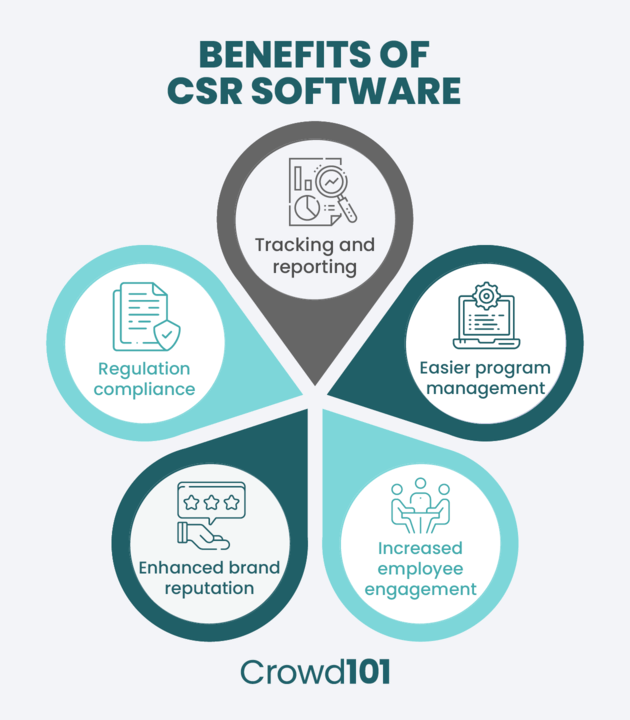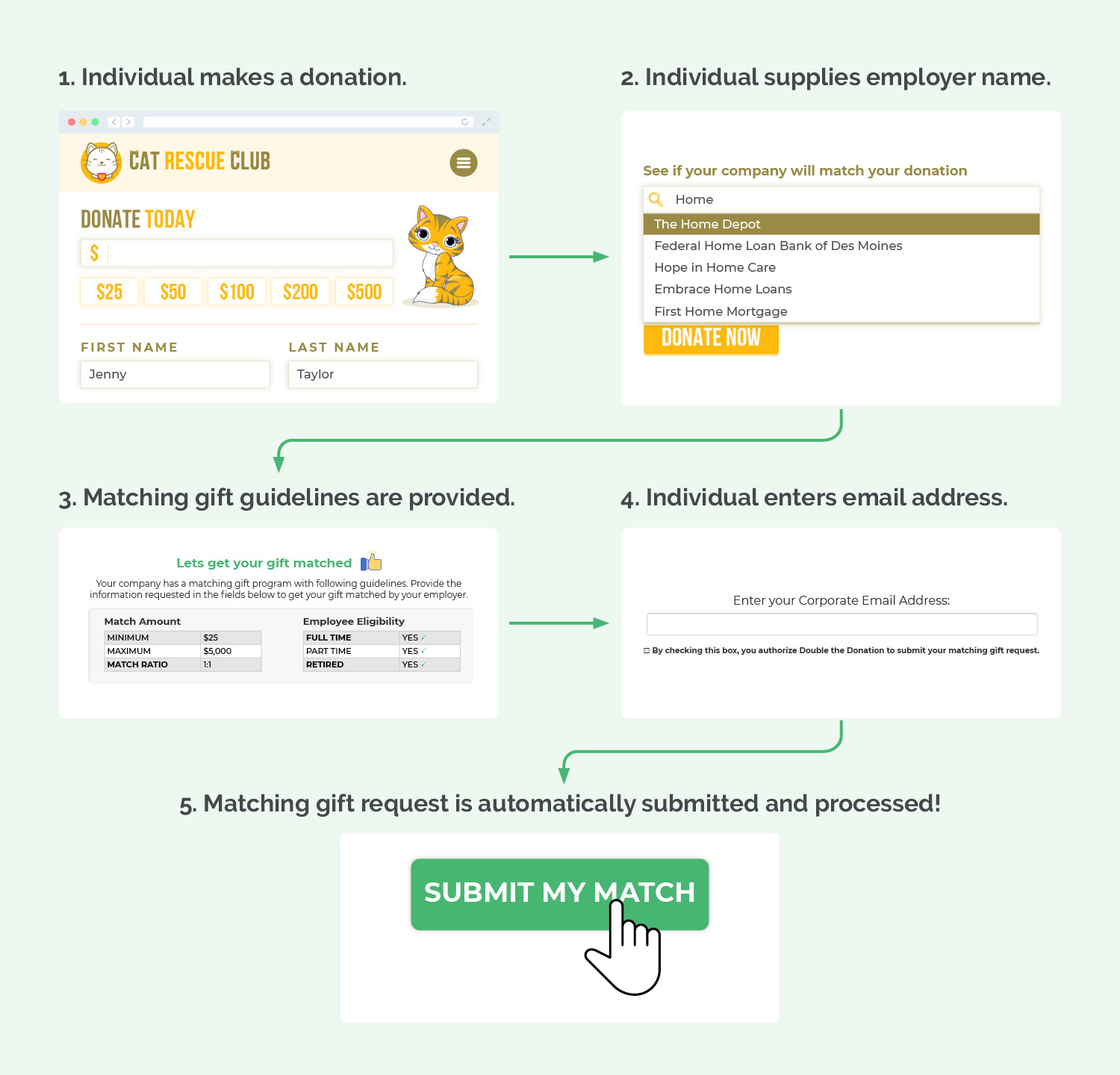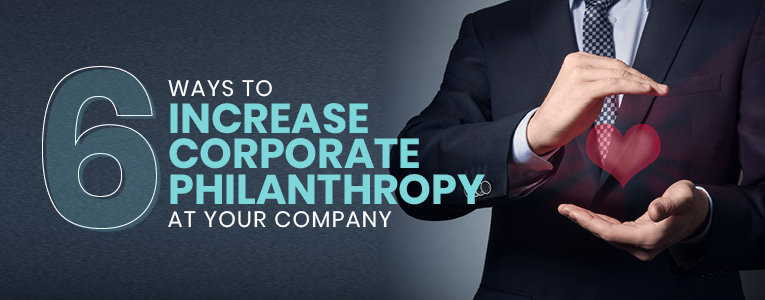6 Ways to Increase Corporate Philanthropy at Your Company
More and more companies are prioritizing social impact and other aspects of corporate social responsibility (also known as CSR) and corporate philanthropy in their business strategies.
Why?
The benefits to participating companies are multifold: corporations are able to attract, retain, and increase engagement with employees; build more positive, mission-minded reputations among existing and potential consumers; and make a significant impact on the greater good.
So if you’re looking to increase your own businesses’ corporate philanthropy efforts—and reap the benefits mentioned above—you’ve come to the right place. In this guide, we’ll share six powerful tips for companies aiming to drastically scale up their social impact.
These best practices include the following:
- Allow employees to choose their causes.
- Offer multiple corporate giving programs.
- Incentivize employee participation.
- Utilize a sense of friendly competition.
- Measure philanthropic impact and growth.
- Enable matching gift auto-submission for employees.
Gaining employee support for any new or increasing giving initiatives will be an essential prerequisite for a successful program rollout. This is particularly important if your philanthropy will rely heavily on employee or workplace giving, which essentially places staff members in the drivers’ seat of the giving programs.
By incorporating these ideas as you develop your corporate giving plan, you’ll be sure to have your workforce on board and ready to participate. Let’s begin!
1. Allow employees to choose their causes.
If you want your staff to eagerly partake in your company’s corporate philanthropy initiatives, one of the best things you can do is provide employees with the agency to determine which organizations and causes will benefit from your giving programs.
For example, let’s say you, as the CEO of your company, are extremely passionate about saving the whales. As such, you plan to organize all of your corporate giving efforts in a way that directs funding toward whale nurseries, ocean conservation, and sea mammal research.
But unfortunately, your employees aren’t as into whales as you are. As a result, they’re not entirely motivated to part with their hard-earned dollars and limited free time to support the whales. Instead, they might be interested in supporting a local soup kitchen. Equipping a school with educational materials. Investing in medical research. Providing international aid.
When you open up your corporate philanthropy efforts to enable more choices as to the types and specific organizations that can benefit from your programming, participation levels will soar.
This is why workplace giving programs such as matching gifts, volunteer grants, and charity gift cards are so popular among employees. They’re provided with a direct say in the nonprofits they want to support!
2. Offer multiple corporate giving programs.
Corporate and workplace giving initiatives are not a one-size-fits-all solution for companies looking to elevate their philanthropy. For example, a program that appeals to Sally from the marketing department might not be the same one that excites your front desk clerk, Bob.
In order to engage with Sally, Bob, and everyone else on your team, we suggest incorporating a wide range of employee giving possibilities. These may include:
- Matching gifts
- Volunteer grants
- Charitable gift cards
- Virtual volunteerism
- In-person volunteer events
(Hint: you can click each of the above links to learn more about the programs!)
And the list doesn’t end there, either. Other impactful corporate and workplace giving programs include cause-based company fundraising campaigns, in-kind donation collections, pro bono staff time, and more.
Top tip: If you’re looking for one of the simplest types of programs with which your team can test the waters of corporate giving, our recommendation is to organize a custom matching gift program. Rather than a traditional matching gift initiative, where the company matches staff donations to any or all nonprofits they support, custom matching gifts differ by focusing all your efforts on a single cause. Plus, it’s typically on a shorter campaign timeline!
3. Incentivize employee participation.
Regardless of the corporate and workplace giving programs you choose to enact, driving high levels of employee participation is essential. And what’s one of the best ways to get staff members ready, willing, and excited to take part in your new or updated programming?
Incentivizing their involvement!
Here are a few of our favorite suggestions for doing so:
- Provide paid time off (above and beyond your staff’s existing hours) to participate in workplace giving and volunteer opportunities.
- Reward high-level givers with public recognition.
- Offer individual prizes to employees upon reaching giving goals (i.e., coffee/snack/meal gift cards, etc.).
- Award group prizes for the company upon reaching participation or revenue goals (i.e., office pizza and ice cream party to celebrate 75% of team members being involved or after reaching $2,500 in employee donations).
Be sure to tailor your incentive ideas to better appeal to your company’s employee base. While some groups might prefer tangible rewards and benefits, others may rather be recognized for their efforts in front of the team. More than likely, you have a good sense of what incentives your workforce responds well to based on previous engagements.
Plus, we can’t overstate the importance of strong internal marketing surrounding the giving opportunities. According to corporate giving research, millions of individuals employed by companies that offer workplace giving opportunities fail to participate in the opportunities due to never being made aware of the programs in the first place.
If your employees don’t know that your company will match their charitable donations, for example, they’ll never know to request a matching gift, even when they’re eligible! Thus, be sure to thoroughly communicate these programs’ existence to your employees.
4. Utilize a sense of friendly competition.
If working together to reach a common goal isn’t enough of a motivation to get your workforce invested in workplace giving, pitting individuals and teams against one another in a gamified way might be just what you need. In that case, a sense of healthy competition can be used to motivate employees to give—and to give more than their so-called “competitors.”
One example that utilizes a number of our best practices involves hosting a bracket-style giving competition such as Giving Madness. Employees interested in this March Madness-based tournament are encouraged to give, vote, and compete in games to drive their favorite nonprofit causes toward the end to win the championship.
Other kinds of gamified workplace giving competitions have been utilized by all sorts of companies for many years. These ideas have included penny war fundraisers, health and fitness challenges, workplace decoration contents, chili cook-offs and cookie bake-offs, and more.
5. Measure philanthropic impact and growth.
As with any new company-wide initiative you plan to roll out, it’s important that you have the structure in place to measure your successes as well as return on investment.
When it comes to corporate giving, being able to measure and communicate the tangible impacts you’ve had can even encourage continued support and participation into the future.
But how exactly can you measure the social impact of your philanthropic programming? Here are a few examples of metrics to track:
- Percentage of employees participating in a particular giving program
- Number of corporate volunteer hours donated
- Total revenue contributed through employee donations
- Total revenue contributed through corporate matches, charitable gift cards, grants, and other company donations
While each of these data points can provide your company with a basic snapshot of how you’re doing at that moment, it’s an even better idea to collect this information over time. This enables you to view giving trends and track your company’s charitable growth as you continue to develop and adjust your strategies.
The best way to measure your corporate philanthropy program’s impact is by using CSR software. This type of tool allows you to track and report on key metrics, monitor goal progress, and make adjustments to your program as necessary.
In addition to defining your program’s success with data, CSR software also offers the following benefits:
- Easier program management. Centralizing your CSR efforts in one platform makes it easier for your company to manage your philanthropic efforts. From corporate giving to employee volunteerism, you can keep all relevant information, forms, and registration links for your corporate philanthropy program organized.
- Increased employee engagement. CSR software makes it much easier for your employees to get involved. As a result, you’ll see increases not only in program engagement but in overall employee engagement at work. Considering companies with highly engaged employees achieve 59% less turnover and a 23% increase in profitability, CSR software can significantly improve business outcomes.
- Enhanced brand reputation. When you can more easily report on your program’s impact, you can demonstrate your company’s commitment to improving the world around you. This dedication to social responsibility can increase positive brand awareness with potential customers, investors, and employees.
- Regulation compliance. Depending on where your company operates, there may be certain CSR regulations and reporting requirements you must follow. Using CSR software to produce your reports can help ensure that you’re in compliance with all relevant rules.

When looking for CSR software, make sure to create a list of features your company needs in its platform. For example, if your company offers volunteer grants, then you’ll want to make sure your software solution allows employees to track their volunteer hours and submit volunteer grant requests.
6. Enable matching gift auto-submission for employees.
Traditionally, matching gifts have been an excellent way to drive corporate philanthropy—but it can leave a big part of the process up to individual employees who may or may not end up following through with the task at hand. That’s why Double the Donation and a select group of partners are developing matching gift auto-submission, to be made available to corporations who use the participating corporate vendor platforms.
Auto-submission functionality, which recently completed its time in beta, empowers more employees to participate in matching gift programs by simplifying—and completely automating—the request process. Whereas employees have often been required to provide donation, nonprofit, and employee information to complete match requests, now, all that is asked of those working for companies with auto-submission is a corporate email address.

Remember, the easier it is for employees to get involved, the more likely they are to do so—meaning, ultimately, the more benefits your business can reap. So if you’re looking for a top-tier corporate giving software provider for your company, auto-submission is a key feature to keep in mind.
Main Takeaway:
Companies such as your own can learn a lot about effective corporate giving practices from taking a lot at the efforts of other established charitable-minded businesses in the space. This is especially true if you’re looking to launch a giving initiative for the first time.
(For example, you can see our powerful tips in action by exploring the policies, strategy, and impact of corporations like these that are already making their mark.)
Once you’ve organized your giving programs, equipped your team with the tools you need for continued success, and have gotten your employees on board, you’ll be seeing the returns on your philanthropic investment in no time.
Further Reading:
- Announcing New Matching Gift Auto-Submission Functionality
- How to Incorporate Social Impact into a Business
- Increase Employee Engagement with Corporate Giving
- Why Do Companies Match their Employee Donations?
- Corporate Social Responsibility: The Definitive Guide
- Corporate Giving and Matching Gift Statistics [Updated 2022]
